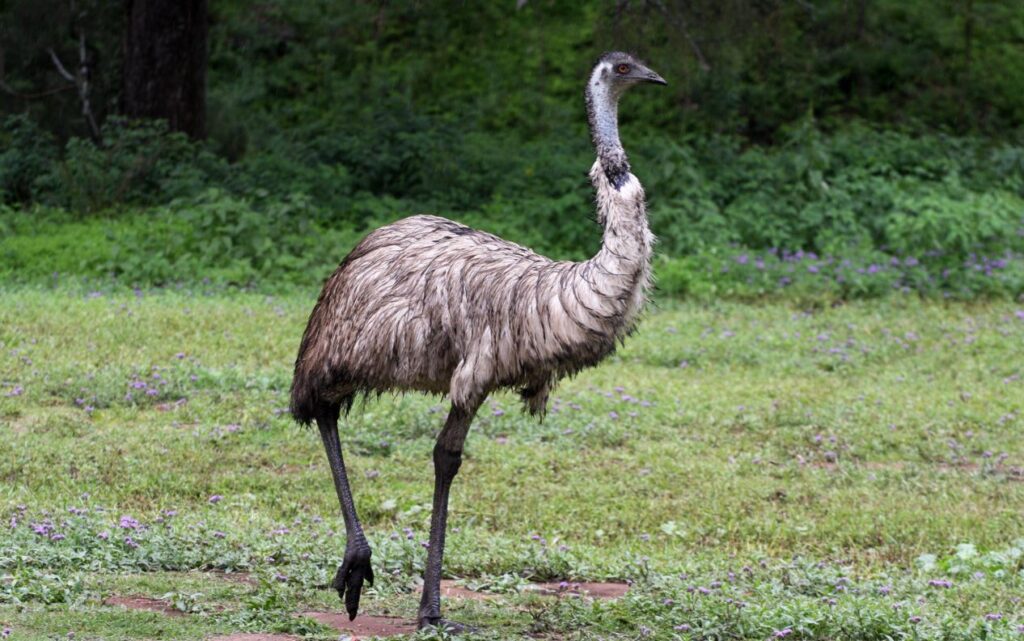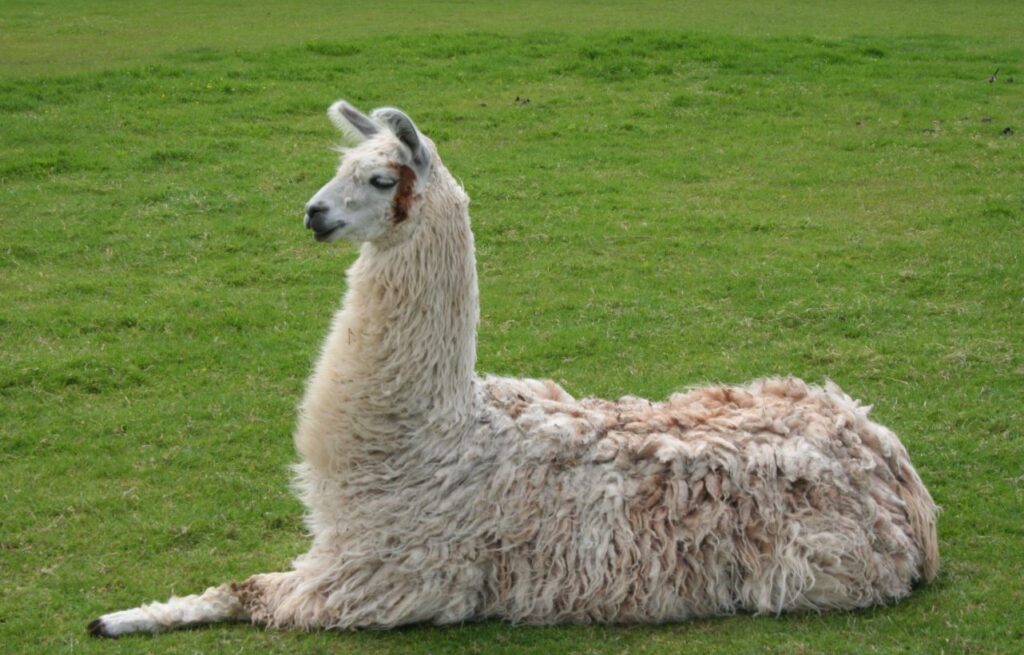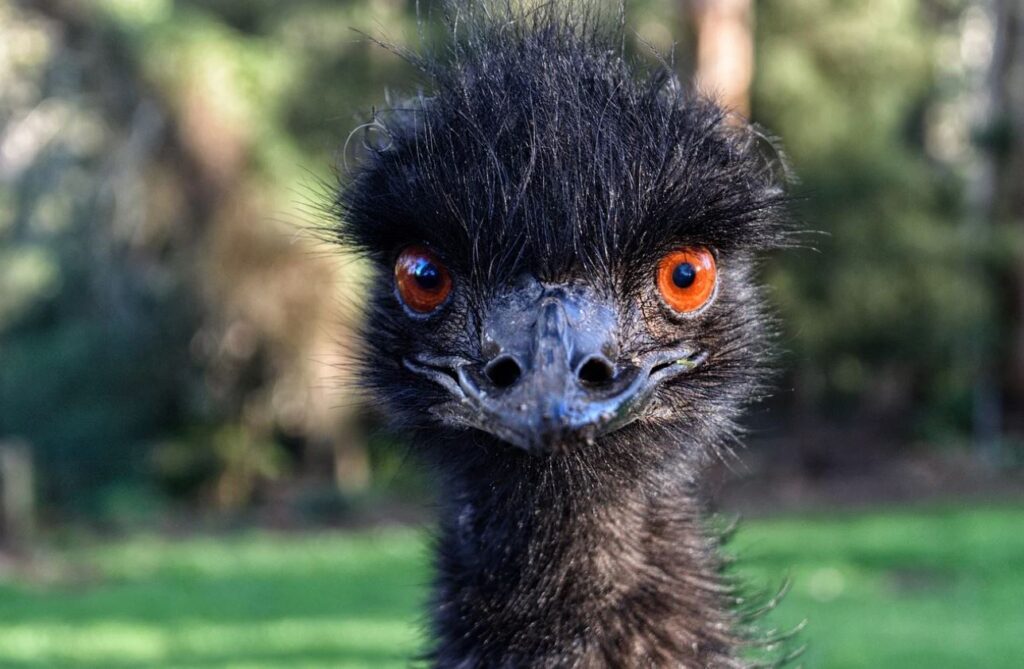These two wonderful sounding animals are so very different that after you have finished reading this article – you won’t be in any doubt as to which is which. You will also learn a bit more about each creature as we go – as both these fantastic animals have a story to tell.
Ways To Tell Emus And Llamas apart:
1: Emus only have two legs holding them up – llamas have 4
2: Emus don’t have ears on the top of their head – llamas have very long ones
3: A llama has two small furry toes – but emus have three giant toes
4: Emus have feathers – llamas have a luscious wool
5: Emus are from Australia, whereas llamas are from South America
So, as you can see – there is no getting these two mixed up anymore. They are so different that you should be able to tell them apart instantly now you have read the following top tips to tell them apart:
1. Emus And Llamas Have A Different Number Of Legs
Emus are bipedal – they have two legs like humans and all other birds. They are one of the three tallest birds on the planet (ostrich and rhea begin the other two) and can top 1.9m (6ft) tall as adults. As a result, they have some of the longest legs of all birds – designed with speed in mind. These giant birds can’t fly anymore, but they can run super-fast: reaching 50km/h (31mph) at top speed.

On the other hand, Llamas are quadrupedal – with four hairy legs like their relatives, the camels. They are a domesticated version of the wild-roaming guanaco found in South America and used as a beast of burden by the cultures in this region – and still are today. They can run quite fast too – but were domesticated for their sure-footed stamina rather than speed.
2. Emus Don’t Have Ears On Top Of Their Heads
Llamas are famous for their large upright ears – often adorned with beads and ribbons at the many festivals and shows in South America. They can fully rotate from front-facing to rear-facing as these herbivores are very wary of pumas and other approaching threats. They can flatten them right down behind their heads, though when angry – and watch out for their mode of defense: a face full of grassy spit!

Emus – being birds – don’t have external ear pinnas. They don’t have anything on the outside of their head that looks like ears as we understand them – but they do have ears, of course. With a series of strategically placed feathers and channels to funnel the sound into their hidden ears, they turn their whole heads to locate sounds rather than their ears alone.
3. Emus And Llamas Have Different Feet
Not only do they have a different number of legs – they also have completely different feet on the ends of them. You won’t always see their feet if they are feeding in long grasses (as they are both grass grazers) – but when you do – the difference is obvious. Emus have three giant long bony toes with nails on end – a bit like a dinosaur. They also still have scaly bald legs – so they look incredibly thin from a distance.
Llamas, on the other hand – being related to alpacas, camels and dromedaries – have two toes on each foot. Short, furry toes – with an ever-growing nail on the end of each that helps increase grip in their rocky and mountainous habitat. They also have very hairy legs, and often this long wavy hair is also on their feet.
4. Biology: Fur And Feathers
As already mentioned – emus are birds – and all birds have feathers. Although the emu’s feathers are soft and fluffy looking, they are still only feathers and need regular preening and dustbathing to keep them looking great. Emus don’t have feathers on their faces and the top of their necks – just fluffy down in various patterns. They do, however, have lovely eyelashes.
On the other hand, Llamas are top to toe in fuzzy fur – white, cream, beige, brown, and black. Needing to keep warm in their Andean homeland, they have thick and extremely warming fur – even in between their toes. This fur is some of the finest in the animal kingdom – similar to chinchillas and angora goats – and has been used to make garments since prehistoric times – and famously with the Incas.
5. Location: Where They Live In The Wild
All across the savanna of Australia – you will find wild emus. They are usually found in pairs or small groups but will join forces to travel to new feeding areas – and when with their stripy young, they can number in double figures. They aren’t found everywhere, though, as they need a certain amount of rainfall to get enough food – acacia and grasses. They will also regularly eat small animals and bugs, including crickets, spiders, and beetles, too, when the opportunity arises.
Llamas are partly wild in South America – but are found as domesticated animals across the world today. Llamas are among the 4 main camelid groups across South America – llama, guanaco, alpaca, and vicuna. Llamas and alpacas are greatly valued for both their stamina, meat, and wool. In contrast, guanacos and vicunas are still living wild in the mountains and grasslands of Peru, Bolivia, Chile, and Argentina.
QUESTION AND ANSWERS
Can Emus Fly?
Emus gave up flying around the time of the end of the dinosaurs. This family of birds, including the historic Elephant Birds and Giant Moas (up to 3.6m (12ft) tall) and modern-day ostriches, rheas, kiwis, and cassowaries, all slowly lost the ability to fly after their main dinosaur predators disappeared. Mainly due to their island locations (with no threats), they could evolve freely into land-dwelling birds – losing the strong breast muscles that aid true flight. Their wings have now shrunk in size too.
Would Llamas & Emus Live Together?
Although both species are now widely kept as livestock, it isn’t always plain sailing with emus and llamas in the same paddocks. Depending on the way they are reared and their ages, it has been tried many times – but on a large-scale farm, it is best to keep the stock separately to better care for and feed them. Hand-reared individual animals may be a different story – but always a risk with such a powerful bird.
Can You Ride An Emu And A Llama?
No – not if you are an adult. Neither a llama nor an emu are designed to carry the weight of an adult human on their backs – and shouldn’t be made to either. Llamas especially bred to be hardy (and with the right saddle) can be ridden by young children (under 22kg/50lbs), but this isn’t their full-time job. On the other hand, Emus will either lay down or kick you if you try to ride them. They can’t take any weight anyway – so kicking you off or giving up is the only way out of it.
Who Would Win In A Race: Emu or Llama?
It would be shoulder to shoulder if you had an emu and a llama run a sprint together. Emus can easily run 50km/h (31mph) at top speed on flat ground, whereas a typical llama (on a good day) can manage 56km/h (35mph). So if the llama didn’t get distracted – they could well win by a whisker.
Do Emus Have Teeth?
Answer: No. Emus are birds and so don’t have teeth at all. They have small serrated ridges on the insides of their beaks instead to help rip up plants and grasses. Some people class the ‘egg tooth’ as a tooth – but it isn’t a real ‘tooth’ – it is only really a bump to crack open the egg from the inside.
Can Llamas And Camels Have Kids?
Answer: Yes – but very unlikely to happen naturally – and the first one was by artificial insemination. Llamas and camels are from the same family, so they can hybridize and produce young – called a ‘cama’ in this case. Llamas often hybridize naturally with alpacas producing a ‘huarizo,’ a sterile smaller version of a llama with longer hair.
Can You Have A Pet Emu?
Answer: Yes. Emu is often kept on farmsteads and private estates – but you need to have the right land and the right paperwork as often emus are described as livestock. They don’t make the best pets, to be honest – but many people raise them from chicks to act as protectors for smaller livestock and eggs – which can be 15cm (6in) long – and very tasty.
Will A Llama Protect Your Sheep?
Answer: Yes, it would. Llamas (and emus) react to predators approaching their herd more quickly and more violently than other smaller livestock such as sheep (who normally just run away). They are well known for their ability to keep most predators away or at least sound the alarm for the farmer to step in.

